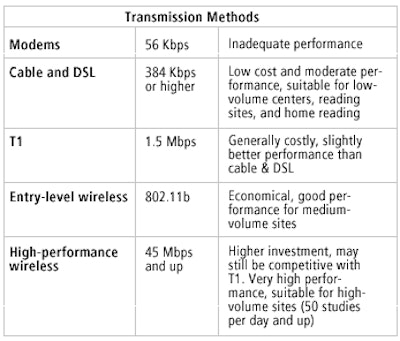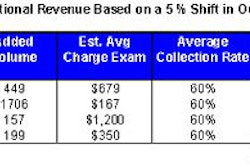
By Dr. Mark D. Herbst, Ph.D.
Wireless communication can be an effective and economical alternative to traditional networking approaches for PACS installations. I have used a wireless image management network for three years at my company, St. Petersburg Independent Diagnostic Radiology (SPIn-DR) in Clearwater, FL.
SPIn-DR was founded in 1998 to provide MRI reading services to independent imaging centers located in areas restricted by hospital noncompete clauses. When I started the business, it was clear that a PACS network would eventually be needed, for several reasons.
Digital images are easier to transport and store, and offer the reader more flexibility to review images and the freedom to zoom and adjust contrast/brightness or window/level. Users can also perform multiplanar or maximum intensity projection (MIP) reconstructions, and can allow referring physicians instant access to medical images via the Internet.
A speedy connection
PACS requires a fast Internet connection and the ability to receive images simultaneously from multiple imaging centers. A simple telephone modem was too slow for my needs, and T1 lines were extremely expensive. Cable Internet access was not available then, and digital subscriber lines (DSL) were in their infancy.
However, a local wireless Internet service provider (ISP) was able to provide an 11-Mbps half-duplex wireless service for less than the cost of a T1 line, which yields only 1.5 Mbps. After installing my first radio link in 1999, I found I could receive MRI scans from centers in about five minutes. Images began arriving from just a few sites, but within two years, growing image volume (and whole-body CT studies that took 30-45 minutes to transmit) led to noticeably slower performance.
I upgraded to a 45-Mbps full-duplex wireless connection to handle more images, bigger files, and more patients. Today I can receive full DICOM CT and MRI scans from any of my referring centers in about three minutes (ranging from 2-12 minutes), depending on the number of sequences and traffic volume.
There are many types of connections available for teleradiology users to choose from, and different levels of radio transmission speed (see chart below).
 |
For medical imaging applications, I recommend at least a cable modem or a DSL connection at 384 Kbps. The need for speed depends on whether you will need to exchange images with one location or many, the size of the image sets, and the importance of fast transmission to your business.
A single radiologist reading 10 scans a day may not need much speed if the images are relayed at night and then read during the day. However, a busy practice such as mine, or a center sending out more than 30 studies a day, would benefit from faster transmission. I use a cable modem at home, and wireless at work.
Bandwidth at work is ample, in order to avoid having any of the dozens of centers sending me images experience slowdown when transmitting studies. At home, where I receive images only from the office, I don't need such a fast connection. Your communications company should be able to analyze your needs and show you a reasonable upgrade path to follow as those needs change.
Hardware
A basic PACS installation can be built from a simple computer, a single monitor, and a fast Internet connection. The workstation need not cost more than about $3,000, and the software can range in price from free up to about $6,000.
I usually use a RadWorks workstation (Applicare Medical Imaging, Zeist, the Netherlands) equipped with a 30-GB SCSI hard drive, dual 550-MHz Pentium III processors, 1 GB of RAM, and a 21-inch color monitor that I run at 1,600 x 1,200 resolution. I also use a laptop with a 15-inch screen, 1,280 x 1,024 resolution, a 30-GB hard drive, a Pentium III processor at 650 MHz, and 384 MB of RAM.
Before SCSI was installed, my images displayed very slowly if I was receiving a study at the same time. Now, with SCSI hard drives, the data coming in can be written to the hard drive at the same time that the DICOM software is reading the scans from the hard drive for display, without slowing down. I prefer one monitor to multiple monitors, and this holds costs down.
Security
Security for wireless-connected networks is handled in the same manner as wired connections. Every workstation needs to be secure from intrusion by hackers to protect patient confidentiality, and some kind of firewall, either software (like ZoneAlarm, BlackIce, or Norton Internet Security) or hardware (like SonicWall) is a must.
Virus protection (such as Norton Antivirus, McAfee VirusScan, or PC-cillin) is also essential. It's a good idea to ask your PACS vendor for an explanation about how their software complies with the privacy and security regulations under the Health Insurance Portability and Accountability Act (HIPAA). I use a simple hardware firewall that cost less than $1,000.
My firewall license covers 50 users, and keeps out various types of intrusions. My Internet and computer consultants have suggested a plan that uses two firewalls for even better security; we plan to implement this approach within a year.
A faster, more flexible connection
Wireless companies offer faster connections, more fixed IP addresses (Internet Protocol -- the number that identifies a computer or device on the Internet), and better service than their hard-wired counterparts. A fixed, public IP address allows a computer to be accessed remotely over the Internet, in contrast to a dynamic public IP address that changes, or a fixed private IP address that cannot be reached from outside an intranet.
A public IP address allows a radiologist’s workstation to receive images from an imaging center or the main office or hospital, or allows the center to host its own Web site on its own computer. This saves the cost of remote hosting. Whatever the initial wireless connection speed, it's possible to start slower and upgrade as needed.
Wireless microwave transmissions could be affected by rain, so make sure your provider understands the engineering requirements for your local environment. If I could not get wireless service, I would choose cable (2 Mbps upload, 4 Mbps download), DSL, or a T1 line.
There are three essential points to remember when dealing with wireless teleradiology:
- Know your vendors. Make sure they understand the radiology world and workflow. My communications company is attuned to my needs and calls me when they sense a problem on the network.
- Have a good service-level agreement. Ensure that you have 24-hour access to the roof and any closets where the radio power and router connections are installed, so you can restore your connection in a hurry. Your vendor must be able to swap out your radio with a replacement within 12 to 24 hours.
- Be familiar with your network equipment and layout, or have a consultant do this for you. Learn the differences between hubs and switches, and go with switches. Make sure you have 100 base-T Ethernet, and not just 10-base T.
The need for a good service-level agreement was evident at my facility this month. Our radio was struck was lightning, resulting in a loss of our connection. Our communications company delivered another radio in a few hours, however, and work resumed.
I plan to install a backup DSL line or frame T1 for use when the wireless connection is unavailable. This will only add a small percentage to the overall cost of the system.
Keep in mind that no service can deliver 100% uptime. Make sure that the service-level agreement assures the fastest repair time, depending on your needs. This applies to the communications company, power company, office management, etc.
The decision to go digital was definitely the right path for my business. The use of wireless broadband service has made a significant contribution to that strategy.
By Dr. Mark D. Herbst, Ph.D.AuntMinnie.com contributing writer
September 3, 2002
Dr. Herbst is founder of St. Petersburg Independent Diagnostic Radiology, a provider of MRI reading services based in Clearwater, FL. For more information on SPin-DR, visit their Web site at www.spin-dr.com.
Copyright © 2002 AuntMinnie.com


















